|
|
|
Sort Order |
|
|
|
Items / Page
|
|
|
|
|
|
|
| Srl | Item |
| 1 |
ID:
129539
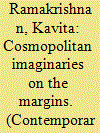

|
|
|
|
|
| Publication |
2014.
|
| Summary/Abstract |
In this article, I examine how social boundaries are drawn and contested by residents in a Delhi resettlement colony, established in 2004 and expanded during the wider slum clearance drive, prior to the 2010 Commonwealth Games. Drawing from life narratives, I explore how residents navigate new social terrains and decide in which situations difference becomes a salient issue. Building on literature that engages with subaltern forms of cosmopolitanism, I argue that openness and conviviality are seen as predominantly urban behaviors, external to that of the colony located on the margins of the city. Residents instead express ambivalent and sometimes contradictory subjectivities in quotidian encounters, and often see social distancing as a necessary tactic. I suggest the narratives offer a nuanced understanding of the multiple constructions of home, community, and belonging amongst the marginalized in and 'beyond' the city.
|
|
|
|
|
|
|
|
|
|
|
|
|
|
|
|
| 2 |
ID:
129529


|
|
|
|
|
| Publication |
2014.
|
| Summary/Abstract |
The urban clearance programmes that were pursued on a vast scale during the Emergency are frequently alluded to by historians but remain poorly understood. In particular, historians have reproduced the assumptions and limited scope of the Shah Commission of Inquiry, which published its reports on the Emergency in 1978. Histories of the Emergency's urban policies have, therefore, focused overwhelmingly on Delhi and north India, on the demolition of buildings, and on the role of Prime Minister Indira Gandhi's son, Sanjay Gandhi, as instigator of these policies. This article uses case studies to demonstrate that these policies were not limited to Delhi and its environs, and to show that a concentration on the demolition of buildings has led historians to neglect the clearing of unwanted people from India's cities. The article goes on to reassess the thinking that underpinned these policies through a case study of Jagmohan, the head of the Delhi Development Authority during the Emergency. It shows how his ideas on urban aesthetics and civics informed the urban clearance programmes and how these authoritarian republican ideas suggest a way of rethinking the history of the Emergency as a whole.
|
|
|
|
|
|
|
|
|
|
|
|
|
|
|
|
| 3 |
ID:
129525
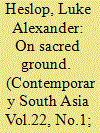

|
|
|
|
|
| Publication |
2014.
|
| Summary/Abstract |
April 2012: In Dambulla, a bustling market town built around a crossroads on the northern cusp of Sri Lanka's central province, a mosque was attacked by a procession of protestors led by the chief priest of the nearby Buddhist temple. Ostensibly the protest was against the presence of the mosque on the grounds that it had been built in an exclusively Buddhist 'sacred area'. Beginning with an empirical account of the attack on the Dambulla mosque, this paper argues that the preservation of what is deemed to be 'sacred' in Sri Lanka provides an effective idiom through which certain religious figures can intelligibly articulate political claims whilst maintaining critical distance from the dirty world of 'Politics'. Corollary to this, and drawing on two years of ethnographic fieldwork in Dambulla, the paper explores the various different meanings of politics locally: highlighting the interplay of everyday politicking and high-profile political performance.
|
|
|
|
|
|
|
|
|
|
|
|
|
|
|
|
| 4 |
ID:
129524
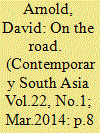

|
|
|
|
|
| Publication |
2014.
|
| Summary/Abstract |
Taking early nineteenth-century European travel narratives as its point of entry, this article suggests ways in which the subject of roads in India can be more fully addressed. Rather than regarding them as purely a means of circulation (of goods, ideas and personnel), roads can be interpreted as a manifestation of linear modes of power and, for Europeans and Indians alike under colonial rule, as a salient site of social observation, engagement and friction. Roads constitute an underappreciated site of social interaction - voluntarily, perhaps, as among pilgrims and other travellers, but also, at the other extreme, through the contrived sociability of individuals' intent on deception and theft. Roads were subject to coercive forms of social interaction as with convicts and famine relief workers obliged to labour on their construction and repair. Roads provided routes to new social locations, but also avenues for political display and ideological intervention and for the articulation of new technologies of social control and state action. Although this article's approach is primarily historical, it suggests ways in which the subject of roads might be of wider interdisciplinary interest and more contemporary significance.
|
|
|
|
|
|
|
|
|
|
|
|
|
|
|
|
| 5 |
ID:
129542
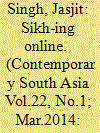

|
|
|
|
|
| Publication |
2014.
|
| Summary/Abstract |
Set in the context of a wider study of processes of religious transmission, this article examines the role of the Internet in the religious lives of young British Sikhs. Having explored the emergence of the presence of Sikhism online, data gathered through interviews, focus groups and a large scale online survey is analysed to understand how and why young British Sikhs use the Internet to learn about Sikhism and how the online environment may or may not impact on their ideas of religious tradition and authority. Using Campbell's [2007. "Who's Got the Power? Religious Authority and the Internet." Journal of Computer Mediated Communication 12 (3): 1043-1062] recommendation that any examination of the impact of the Internet on religious authority needs to be sufficiently contextualised, I argue that the effects of the online environment on traditional sources of religious authority are not as stark as scholars studying the early impact of the Internet suggest. Given that 'going online' has become an everyday practice for many young people living in Britain, this article contributes to understanding the online religious lives of young people in general, and young British Sikhs in particular.
|
|
|
|
|
|
|
|
|
|
|
|
|
|
|
|
| 6 |
ID:
129526
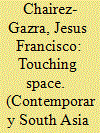

|
|
|
|
|
| Publication |
2014.
|
| Summary/Abstract |
Although B.R. Ambedkar, the chief architect of the Indian Constitution, is well known for his struggle against caste and the practice of untouchability, his ideas have seldom been linked to concepts such as nationalism or space. In an attempt to shed some light upon this under-explored subject, I analyse the relationship between the village, the city, the practice of untouchability and the emergence of nationalism in Ambedkar's thought. Focusing primarily on his writings, post 1935 concerning untouchability, I will argue that for Ambedkar, space played a critical role in both the perpetuation and evanescence of untouchability and similarly in the neglect and emergence of nationalism. More specifically, a small locus with tightly knit social and commercial associations, such as the Indian village, facilitated the ongoing differentiation of the population into two distinct groups, touchables and Untouchables. This social and spatial segregation perpetuated the practice of untouchability while preventing the growth of nationalism. However, a bigger and more crowded setting, such as the city, not only complicated the observance of social norms such as untouchability, but also benefited the creation of a corporate feeling of 'oneness' among individuals, which according to Ambedkar, was a condition for the emergence of nationalism.
|
|
|
|
|
|
|
|
|
|
|
|
|
|
|
|
|
|
|
|
|